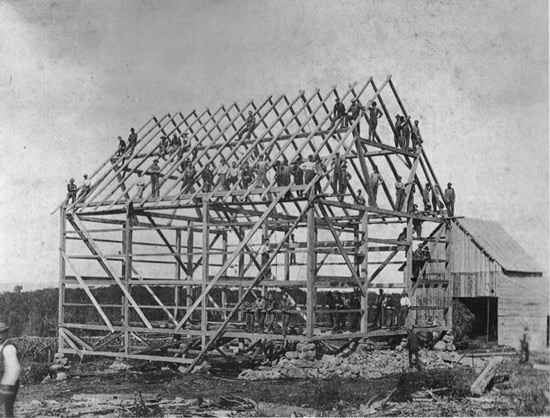B A C K T H E N
Raising a Barn in Chelsea
Photo courtesy of Maine Historic Preservation Commission
Raising up a barn in Chelsea, likely turn of the century. Evidently this is a traditional community effort, or “bee.”
Evidently a ramp will be required to reach the main doors. This is probably ledgy ground, resistant to excavation, but as the owner wanted to have a manure cellar, the main floor has had to be elevated. The frame is a mix of old and newer practices. The absence of a ridgepole was standard with this construction, since the horizontal roof boarding will give the rafters all the lateral strength required. Barns and cape houses built before the Civil War generally had roofs boarded vertically over purlins between the heavy rafters that corresponded with the vertical posts, a method that required fewer nails (then not readily available) but longer boards. If a leak developed, the extent of the resulting rot was more limited than with horizontal boarding.
Traditional barn builders, with access to a good woodlot, marked all the frame measurements on a single eight-foot “story pole,” which was carried into the woods. Frame timbers were commonly of chestnut, a magnificent species since wiped out by blight, or else of youthful and robust (not old and shaky) hemlock or pine. Frame members were joined with mortice-and-tenon joints, pinned with oak or locust treenails. Frame sections, or “bents,” were assembled flat, and then were stood up with poles. Note the clever bracing of the long purlin timbers. The acute angle of this roof is going to make shingling and shingle repairs an adventure, but the farmer will never have to lie awake during a heavy, wet, March snowstorm worrying about snow load. The gaps between the foundation piers will be filled in with stone walls at his leisure. Not every farmer had the ability or the time to oversee the building of a barn, and many were framed by professionals.
The frame of Mr. B. F. Hilton’s new barn in Anson was raised on Saturday, Oct. 1st, one hundred and twenty-five being present at the raising. The frame was got out by the Kennebec Framing and Lumber Company of Fairfield, and it went together like clockwork. Every stick is planed and firmly pinned and bolted together and contains above the sills 30,000 feet of timber. The barn is 140 feet long, 47 wide, and 20 feet posted; to cover it will take 20,000 feet of boards and 76,000 shingles. The entire party of men were furnished a real old-fashioned dinner prepared by Mrs. Hilton, the tables being fairly loaded with the best things eatable. – The Eastern Farmer in The [Bangor] Industrial Journal, Nov. 4, 1887.
Text by William H. Bunting From A Days Work, Part 2, ASampler of Historic Maine Photographs, 1860-1920 , Part II. Published by Tilbury House Publishers, Gardiner, Maine, 800-582-1899

